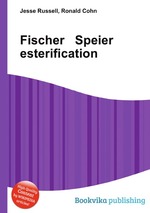Fischer Speier esterification
Jesse Russell Ronald Cohn
бумажная книга
High Quality Content by WIKIPEDIA articles! Fischer esterification or Fischer–Speier esterification is a special type of esterification by refluxing a carboxylic acid and an alcohol in the presence of an acid catalyst. The reaction was first described by Emil Fischer and Arthur Speier in 1895. Most carboxylic acids are suitable for the reaction, but the alcohol should generally be a primary or secondary alkyl. Tertiary alcohols are prone to elimination, and phenols are usually too unreactive to give useful yields. Commonly used catalysts for a Fischer esterification include sulfuric acid, tosic acid, and Lewis acids such as scandium(III) triflate. For more valuable or sensitive substrates (for example, biomaterials), dicyclohexylcarbodiimide is often used. The reaction is often carried out without a solvent (particularly when a large reagent excess (e.g. of MeOH is used) or in a non-polar solvent (e.g. toluene) to facilitate the Dean-Stark method. Typical reaction times vary from 1–10 hours at temperatures of 60-110°C.


